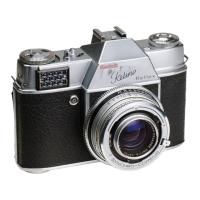subject nearer. It also permits a greater camera-to-subject distance in portraiture, producing a more pleasing
and subdued perspective. At the same time, its lesser depth of field concentrates definition on the portrait,
avoiding a sharp background which would detract from the main object.
Focusing and Viewing
Using a wide-angle or telephoto lens focusing is not different from that of the standard lens. The Retina Reflex
screen enables the image to be focused accurately by means of the split image rangefinder or on the ground
area.
At the same time, the reflex screen shows the exact field of view of the particular lens used. There is no parallax
error.
THE RETINA REFLEX IV
THE RETINA REFLEX IV camera is fitted with either the four-element Retina Xenar f2.8 50 mm. or the six-
element Retina Xenon f1.9 50 mm. Both have an angle of view of 47° and permit focusing from infinity to 24 in.
(60 cm.).
The complete lens is interchangeable against wide-angle and tele-photo lenses. The built-in photo-electric
exposure meter is directly coupled to the aperture setting. The meter needle is set in the viewfinder without
taking the camera from the eye. The exposure meter needle is also visible in a window on top of the camera.
A red signal appears in the viewfinder when there is insufficient light to take the picture. The shutter speed and
aperture are reflected into the viewfinder. The reflex screen has a fresnel lens, yielding a brighter image. The
split image rangefinder has a diagonal cutting line for easy vertical and horizontal focusing.
The built-in Synchro-Compur shutter has cross-coupled shutter speed and aperture settings and is X flash
synchronized with direct flash contact in accessory shoe and flash contact on camera body. The exposure
counter is self-zeroing and the rewind knob is fitted with a foldover hand crank.
The f2.8 lenses accept 32 mm. screw-in filters and close-up lenses (32 mm. is the outside diameter). The lens
hood is rectangular with a tubular bayonet fitting on the back to fit the bayonet mount surrounding the lens
itself.
The f1.9 lenses accept filters and close-up lenses of 60 mm. diameter. No lens hood is ordinarily required as the
lens is deeply recessed in its mount.
OTHER ACCESSORIES include a close-up attachment, table stand, copying stand, 1:1 close-up stand, microscope
adaptor, and framefinder.
The film speeds are set on the film speed dial with the aid of the locking knob on the back of the camera and the
exposure wheel. The meter needle is visible in the needle window on top of the cameras well as in the
viewfinder. A lens setting reflector above the lens also shows apertures and shutter speeds in the viewfinder.
The rewind knob is fitted with a rewind crank. An automatic depth-of-field indicator is coupled with the aperture

